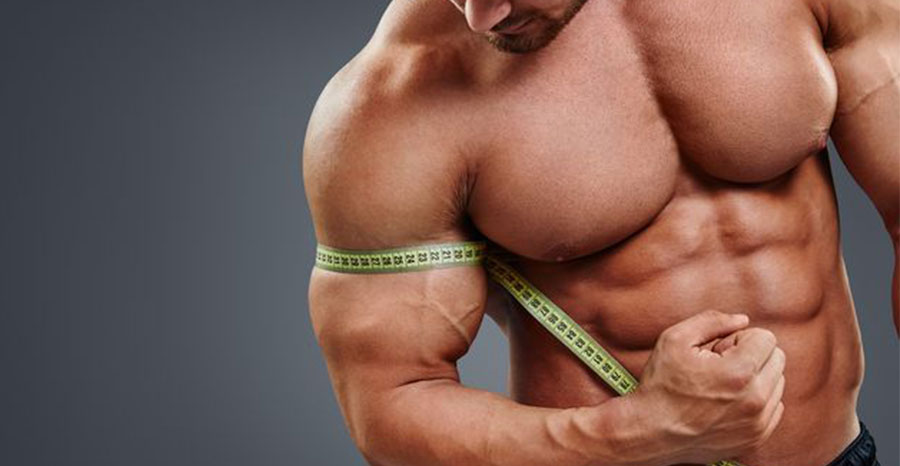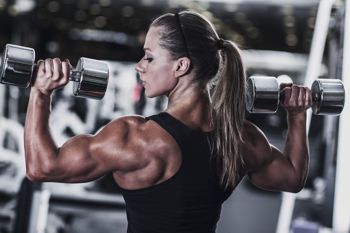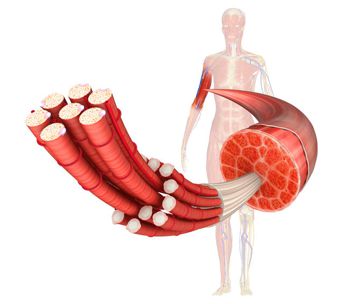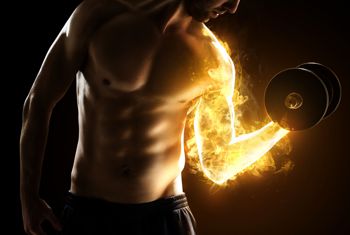
How We Build Muscle: Physiology 101

Most men, especially young men, are at the gym primarily to build muscle or at least maintain it. Some women too are out to add mass. Ignoring those who may be going a little too far, the fact remains that increasing muscle mass is good for us. It makes our body more resilient and increases our resting metabolic rate, which makes it easier to keep the fat off. But why does our body build muscle? What exactly is happening in our muscle cells that cause them to grow?
While physiological factors such as lower testosterone levels prevent women from gaining as much mass as some men, they can still build impressive physiques.
We Don’t Grow in the Gym
We focus a lot of energy on those muscle building workouts, but the muscle doesn’t actually grow in the gym. In fact, just the opposite. During an intense workout with heavy weights, we’re actually damaging our muscles. But that’s where the magic starts.

Muscle cells and the bonds between them break down during a workout. Our body responds by repairing this damage in an effort to make us strong enough to endure lifting those weights without damage. This is because our body is programmed to adapt to stresses in order to avoid future damage. It’s the reason our heart and lungs get stronger when we do intense or long-duration cardio, and the same process causes our skeletal muscles to grow in response to being put under the strain of lifting heavy weights.
Our muscles are composed of myofibrils – long strands of tubular-shaped muscle cells called myocytes.
Growth of the skeletal muscles will continue as long as we keep raising the bar. Every time we get stronger we raise the weight. We keep getting bigger and stronger until we reach our genetic potential. Some people choose to use steroids to push past that genetic potential, but we have no opinion on that.
This means that the actual growth of our muscles happens while we’re resting, not while we’re training. The intensity of the exercise is only relevant to how much damage it does to the muscles. The more micro-damage we do, the faster our body will respond. To a point, of course. We can undermine our efforts in two ways.
Failing to Grow
Training hard but failing to grow? There are two likely reasons why. Either you’re training too hard or too often, or you’re not eating enough. The latter is the problem encountered by most newbies. They hit the weights hard but just can’t seem to make any progress. Many of them give up after a while, writing themselves off as ‘hard gainers’. While it has been scientifically proven that some people respond more readily to training than others, the person who simply can’t build new muscle is exceedingly rare. If you’re not gaining, eat more. A man of average size will need around 4,000 quality calories per day to see appreciable growth.
You might also be training too hard or too often. If you’ve been training for weeks or even months and you’re still sore after every workout, ease off some. You might be doing so much damage to your muscle cells that they simply can’t recover during your rest periods before being hit again. The other possibility is that you’re training too often. Remember, your muscles grow during rest, not during your workouts. If you’re hitting the same muscle groups hard more than three times per week, you’re likely not giving them enough time to recover.
The Actual Chemical Process
When we build muscle, we’re not actually adding more muscle cells. We’re born with all the muscle cells we’ll ever have. The process of adding new muscle fibers is known as hyperplasia, and it doesn’t happen in mammals. Ever. What we’re actually experiencing when our muscles grow is called hypertrophy. This means that the cells we already have are getting bigger. But why?
What’s going on at a molecular/chemical level that causes our muscles to respond to training by getting bigger and stronger, and is there anything we can do to enhance that effect?
The Short Answer
The truth is we don’t fully understand the chemical processes that cause muscle cells to grow. We’re pretty sure it goes something like this though…

We put our muscles under stress, causing a buildup of lactic acid, which is an inflammatory. It’s this inflammatory effect, combined with additional blood flow to the muscles, which is responsible for ‘pump’. Your muscles are actually swelling. Your body then releases cortisol in response to the inflammation. Cortisol is a hormone from your adrenal gland that acts as an anti-inflammatory. One of the things that cortisol does to fight inflammation is to break down proteins (yes, muscle tissue!) into its constituent amino acids for an alternate fuel source, as the workout has burned up all the glucose in your muscle cells. Your body responds to this breakdown of muscle fibers by repairing the damage. When repair exceeds damage, we experience hypertrophy. Bigger and stronger muscles. This is a very simplified explanation but it will do to be getting on with.
Most of us have experienced ‘burn’, the intense pain that comes on those last few reps. This burn is the result of acidic conditions and the release of hydrogen ions which occur when our muscles run out of oxygen and enter an anaerobic state.
Can We Do Anything to Speed the Process?
Now for what most of us really want to know. Is there any way to ensure an optimum balance between the catabolic processes resulting from cortisol release, and the anabolic process of muscle repair?
The answer is yes. Proper diet, training and rest. The harder we train the more inflammation we cause. While being careful not to actually tear muscles we should be pursuing maximum pump with each workout. The more pump, the more cortisol will be released. The more cortisol the more micro-damage will occur. The more damage our body has to repair the harder it will work to do so. Add to this formula a proper high-calorie diet loaded with proteins as well as healthy fats and complex carbs, and at least eight hours of rest per night, and you should be maximizing your muscle growth.
Will Dove
Latest posts by Will Dove (see all)
- Body Weight Training 2.0: Calisthenics - 22 Apr
- All About Protein Powders - 9 Apr
- Top 5 Fitness Trends for 2019 That You Should Try - 30 Mar
